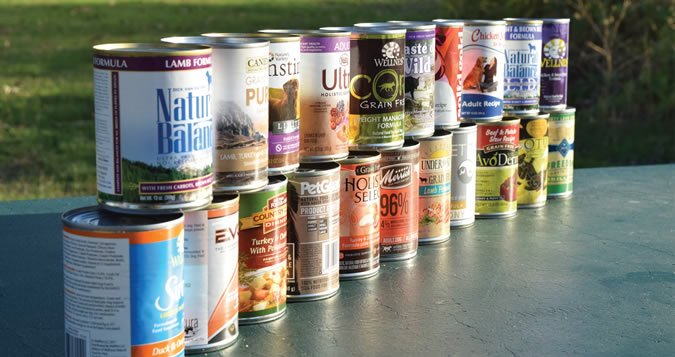How many of you feed canned food to your dog every day? Or maybe I should ask, how many of you feed only canned food to your dog every day?
While we’d like our annual canned dog food review to be of use to owners who feed any amount of canned food to their dogs, it should be most relevant to people who rely solely on canned products to provide “complete and balanced nutrition” to their dogs, without much supplementation from any other type of food. Why? Because the more we question pet food companies about what’s in their food, the less confident we become about whether they even know.
When we review dog foods, we generally ask the companies that make the foods that meet our selection criteria for a good food some additional questions. This year, we asked this: “Do you have a complete nutrient analysis for each of your products, and, if so, do you make it available upon request or is this information on your website?” We were very unhappy with most of the answers.

Most pet foods on the market – including all the ones we recommend – are what’s called “complete and balanced.” This means they have met the standards of the pet food regulators in this country for a diet that is formulated to provide everything a dog needs to survive and (one hopes) thrive. But when we asked the makers of “complete and balanced” dog foods whether they have lab tests that show how much of each nutrient required by dogs is typically present in each of their formulas, very few of them had this information readily available!
Got that? “Feed our food, it contains everything your dog needs . . . but we can’t (or won’t) tell you exactly how much of each required nutrient it contains.”
We’ve charted the answers we got to our survey on page five of our November 2015 issue. The food companies appear in order of how good we feel about their responses.
- At the top of the chart are the two companies we surveyed that post the complete nutrient analyses for all of their products on their websites. We admire and respect the professionalism and transparency.
- Next are the companies that claimed to make their complete nutrient analyses available to consumers upon request, and who were able to follow up this claim by providing some samples of these analyses to us (some in a more timely manner than others). It became apparent that some of them ordered some analyses from their labs just to provide them to us – sweet, but in our opinion, these are something they should have in hand anyway.
- At the end are the companies that answered our survey by saying, straight up, that they do not make their nutrient analyses available to consumers. While we’d far prefer for a company in the business of making food to openly share information about the nutrients contained in their products, we have a measure of respect for the ones that were straightforward about this and had reasons for their policy. Each of the companies in this category claimed that, if need be, they could get whatever specific information about their food was needed to a consumer whose dog had a health problem and whose veterinarian needed the nutrient data. Let’s hope this is true.
Whether this is justified or not, we were more disappointed with the companies that answered our survey by saying blithely that they do make these analyses available to consumers upon request – but then, when asked to provide a couple of these analyses to us in order to verify their claim, couldn’t or wouldn’t produce the analyses. In some cases, we were left convinced that if they ever had the information, it certainly wasn’t available to the pet food company employees tasked with answering questions from us – or consumers – about specific nutrient levels in their products.
In a few cases, we found ourselves explaining to the pet food company employees who answered the phone (or email) exactly what a “complete nutrient analysis” is. This happened several times; in each case it was after the person sent us either a link to a web page or emailed us a document that contained guaranteed analyses for their products, as if they didn’t know the difference!
More Information is Always Better
In case you don’t know the difference – as every pet food company employee should – the “guaranteed analysis” is that little box that appears (by federal law) on every pet food label and contains (at least) four things: the minimum amount of crude protein and crude fat in the food, and the maximum amount of fiber and moisture in the food. If pet food companies want to, they can put more nutrients in the guaranteed analysis (GA) box, but only those four macronutrients (protein, fat, fiber, moisture) are required there.
Whether the pet food company puts just the four required nutrients in the GA or lists a lot of nutrients, a nutrient’s presence in the box means that the pet food company is literally guaranteeing that those nutrients are present in those amounts. The information in a GA is subject to surveillance and enforcement; feed control officials in each state have the authority to run tests on the food and stop its sale (in that state) if anything in the GA is not accurate.
Keep in mind that pet food companies are not required to list any other nutrient amounts on their labels; only protein, fat, fiber, and water are considered to be useful for consumers to know in order to compare products and to judge which might be best for their dogs. But even though the amounts of vitamins and minerals present in “complete and balanced” foods may vary widely, you’d never know this from reading the label. As long as the foods met one of the two standards for a “complete and balanced diet,” they get to have that statement on their label, causing almost everyone to consider them as equivalent and interchangeable, even though they are far more variable than that.
There are many good reasons to investigate the “actual” or “typical” nutrient levels in your dog’s food, especially if he has any sort of health condition that can be affected by high or low levels of some nutrient, such as copper storage disease or anemia.
Some foods may contain very high levels of some nutrient or another – or, as is often the case if extremely high-fat foods, if the nutrients are reported on a caloric basis (corrected for energy density), they may actually fail to reach the minimum levels of many nutrients called for in the Canine Nutrient Guidelines from the Association of American Feed Control Officials (AAFCO). This latter reason is why we also asked the companies for nutrient analyses “by calories” – in very high-fat foods, this may reveal nutrient levels that are below the AAFCO minimums.
Highly motivated owners can request complete nutrient analyses from the pet food companies – and avoid the companies that can’t deliver these.
The next step would be to compare the results received with the AAFCO nutrient guidelines (they can be found online). The next hurdle would be converting the “as fed” numbers that most companies report with AAFCO’s “dry matter” numbers – not exactly rocket science, but it helps to know your way around a calculator.
We will discuss how to do this in an upcoming issue; our dry food review appears in the February issue and we’d love to help you reach competence at this task (if you are interested) by then.
Earning the “Complete and Balanced” Title
Consumers should be aware that foods that have earned the appellation of “complete and balanced” via the “feeding trials” qualification – considered by many as the “gold standard” for achieving this status – may have a number of nutrient levels that don’t meet the AAFCO Canine Nutrient Guidelines.
Yes, it’s true: Foods that have passed a six-month feeding trial might not meet the AAFCO minimums, because they have “proven” their nutritional adequacy by keeping a population of test dogs alive for a whole six months! In our opinion, it’s even more important to take a look at the complete nutrient analysis of a food that has met the “feeding trial” standard than a food that has met the “nutrient levels” standard.
We’ve discussed this many times in WDJ, but for the sake of our newer readers, let’s review how a pet food may earn the privilege of putting a notice on the label that alleges that the product provides “complete and balanced” nutrition for dogs.
There are two main ways that a food can qualify for this legally defined designation. We will call the first one “feeding trials” for short, and the second one “nutrient levels.”
√ Feeding trials: Look long and hard at the cans of dog food in your pantry; if you look hard enough (get out the reading glasses!) you will find a statement that references either “feeding trials” or “nutrient levels.” Feeding trials are just that: The food under study is fed to a population of dogs for a set period of time, and most (not all) of the dogs have to survive in reasonably good health. These trials are costly, but big companies, with deep pockets and a decades-long history and plan for the future, may spend a ton of money and a good bit of time putting their food to the test in feeding trials.
√ Nutrient level: If the company is smaller, new, or its plans more modest, it will likely try the second method for proving its products’ nutritional adequacy: the nutrient levels qualification. Essentially, this means the food is tested, all the nutrients in it are tallied, and the results are compared to a table of nutrient values that is accepted as “what dogs need” by pet food regulators in this country (there are other, slightly different tables of nutrient values used by pet food regulators in other countries).
This standard isn’t perfect, either. A food may contain all the nutrients it’s supposed to have, and yet be highly unpalatable – and if dogs won’t eat it, they certainly can’t benefit from it. Or, it may be palatable, but indigestible! Just because a dog eats it, doesn’t mean he can utilize all the nutrients in it.
In the best of all possible worlds, a food would qualify by a feeding trial and by meeting the AAFCO canine nutrient levels. But this is not a current regulatory requirement!
Make sure when you look for the statement of nutritional adequacy, you notice whether it references “adult maintenance” or “dogs of all life stages.” If the label references “dogs of all life stages” it is formulated to meet the higher nutrient levels required by puppies and pregnant or nursing moms.
2015 List
Below is our list of selection criteria – hallmarks of quality – that we use to identify products we would consider feeding to our dogs. We also list disqualifiers – traits that eliminate products from our consideration. You can use these criteria to analyze the ingredients list on the label of any food you’re considering feeding to your dog.
Starting on the facing page, we’ve listed brief descriptions of some companies that make foods that meet our selection criteria. These are listed alphabetically by the name of the company, not in any sort of rank order.
All of the foods you see on our list of approved foods are good – way better than what you’d typically find in discount or grocery stores. But it’s indisputable that some are better than others on the list. We like to give readers a range, because the availability of some of these foods is so limited in some markets and rural areas, and because some of these foods are wildly expensive – far beyond the means of many pet owners to feed on a daily basis – we’ve also included some that are more modestly priced.
If you don’t see the name of a food you’d expect to see on our approved foods list, make sure you are looking it up by the name of the company, which may be different from the name of the food. Also, check the list of companies (above) that wouldn’t disclose their manufacturing sites or who chose not to respond to our survey this year; those companies make some nice foods, but their lack of disclosure makes us uneasy.
Depending where you live, the foods on our “approved foods” list may be difficult to find; most are sold in independent pet supply stores, or high-quality “pet specialty chain stores.” Don’t forget that these foods are going to be far more expensive than any “grocery store” foods you may find; quality ingredients really do cost more than low-cost fillers like wheat gluten and animal by-products.




